As a concerted effort to inflame tensions in the South China Sea, the recent Felipe Reef debacle is in a class of its own. The objective is to create conflict, continue the Visiting Forces Agreement (VFA) and mitigate Duterte’s legacies.
The Whitsun Reef, known in the Philippines as the Julian Felipe Reef, is part of the contested Spratly Islands in the South China Sea. In Manila, the Reef narrative has been promoted particularly by the part of local media that in the past has been linked with foreign funding and interests.
The issue has been touted by Defense Secretary Delfin Lorenzana, even Foreign Secretary Teddy Locsin, Jr.
According to China, the fishing vessels at the Reef were sheltering from bad weather and had no plan to stay there permanently.
As several Philippine observers have noted, the Reef was officially named as Julian Felipe only in 2008; China and Vietnam had their names for it before World War II. Nor has Philippines tried to enforce its sovereignty over the contested area, where Vietnam’s occupation began a year before the fall of Saigon, perhaps in the interest of US oil exploration companies.
The photos of the original Philippine Coast Guard report (March 7) did not show a militia or arms on vessels. Two days later, satellite photos of the reef, by a Florida-based US high-tech firm Simularity Inc., surfaced showing 200 fishing vessels.
The narrative describes what the debacle is about. But why does it take place now?
BGA, Stratbase/ARD, Simularity and other links
The high-profile Reef debacle is not the first time that most of its central characters – media, think tanks, government representatives, and Simularity – got together. That happened five months ago. Last November, the topic of the annual Pilipinas Conference was “the Philippines and the Indo-Pacific”. Sponsored by ex-foreign secretary Albert del Rosario’s think-tank ADR (initials from Rosario’s name) and BowersGroupAsia (BGA), it held that the shifting balance of power and COVID-19 had “created an opportunity for smaller to middle powers [read: Philippines] to play a more significant role in the region.”
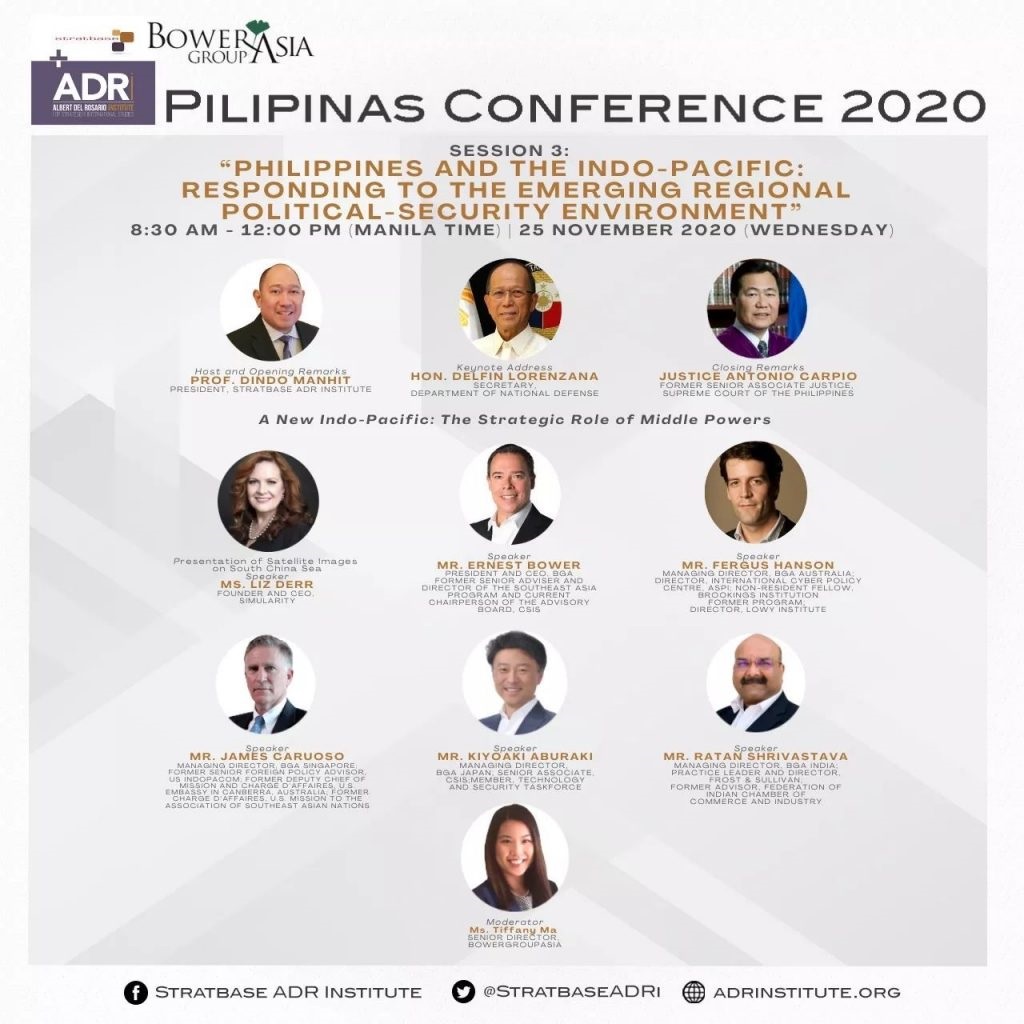
Pilipinas Conference 2020: Session Program
Source: BowersGroupAsia (BGA) website
The keynote address was given by Defense Secretary Lorenzana, who was followed by Liz Derr, CEO of Simularity, the source of the Reef debacle’s satellite images. They were seconded by a group of speakers, mainly BGA country chiefs representing the Philippines, Australia, Singapore, Japan and India, and Southeast Asia. The closing remarks were given by former Justice Antonio Carpio, who Filipino critics call Sinophobic. Most have had a role in the subsequent Reef debacle.
For all of its rhetoric about “avoiding great power politicking,” BGA is linked with the US Center for Strategic and International Studies (CSIS), a well-financed global think-tank “dedicated to finding ways to sustain American prominence and prosperity.” Its major funding stems from defense contractors, such as Northrop Grumman, Lockheed Martin, Boeing, General Dynamics, and General Atomics.
The BGA/CSIS links include BGA President Ernie Bower; a CSIS veteran who chairs the CSIS Advisory Board on Southeast Asia and remains a member of Rosario’s think-tank board. BGA Japan’s head Kiyoaki Aburaki is CSIS senior associate, while the BGA Singapore head is James Carouso; an ASEAN veteran and former senior advisor of US INDOPACOM, the unified combatant command of the US Army for the Indo-Pacific.
One of the many CSIS initiatives is the Asia Maritime Transparency Initiative (AMTI) led by Gregory Poling. Both have played a central role in most South China Sea debacles, through interviews and satellite imagery.
Public agendas, strange bedfellows, private interests
Simularity promotes itself mainly with stories by Philippine-based media, including Rappler, CNN Philippines, Philippine Star, GMA News, Philippine Daily Inquirer, ABS-CBN News, and the Philippine Center for Investigative Journalism (PCIJ). In the past, the PCIJ and Rappler reportedly have received funds from the National Endowment for Democracy (NEDA), via US Agency for International Development.
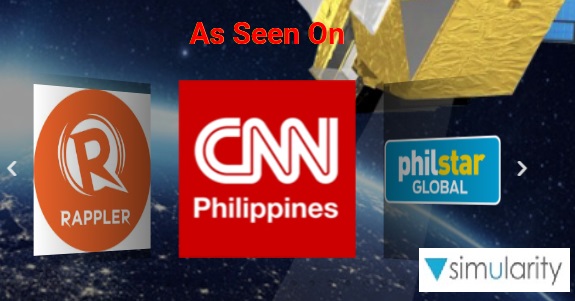
Simularity Inc: Promotion through Friction
Source: Simularity Inc website. Retrieved April 10, 2021
Other sources include Radio Free Asia, center-right NewsCorp media in Australia, BBC News and other media based mainly in the US and Australia, and Vietnam.
As before, several conference speakers have been featured by local media and CNN Philippines, as “independent experts” on South China Sea, including AMTI authors and Rosario-linked analysts (Richard Heyderian, Renato Cruz de Castro, etc). For instance, de Castro started his studies as U.S. State Department ASEAN Research Fellow, serves as an author for CSIS/ATMI, was consultant for ex-President Aquino’s National Security Council and remains trustee in the think-tank of Albert Del Rosario. On the CNN Philippines interview, he was portrayed as an academic, which he is, and an “independent expert”, which he is not.
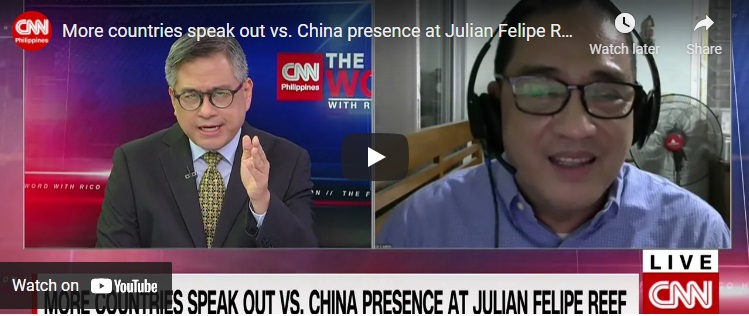
Blurred Boundaries: Advocacy Vs. “Independent Experts”.
Source: CNN Philippines, March 25, 2021.
Of the speakers, Judge Antonio Carpio recently took a far more political role, timed amid the Reef brouhaha. In mid-March, he and Rosario launched a 1Sambayan, a broad coalition of “united opposition” parties for the 2022 election. The strange bedfellows include the Liberal Party, which suffered a meltdown in the 2016 election, military hawks, ex-coup plotters, and closeted ultra-left.
A key background figure behind the group is ex-foreign secretary Albert del Rosario, a millionaire business executive, who is behind Stratbase and ADR Institute, the co-sponsor of the 2020 Conference. In the past, Philippine critics have linked Rosario with regional conglomerates, concession rights, and allegations of conflict of interests regarding South China Sea.
Through its board members and executives, Rosario’s ADR is joined with its parent, Stratbase, an “advisory and research consultancy," as BGA's Philippine partner. Due to the interlocking leaderships, Stratbase head Victor Manhit serves as ADR’s president, while heading BGA's Philippine branch. Truly independent think-thanks do not favor parallel structures, particularly with foreign interests. The Stratbase/ADR is an odd anomaly.
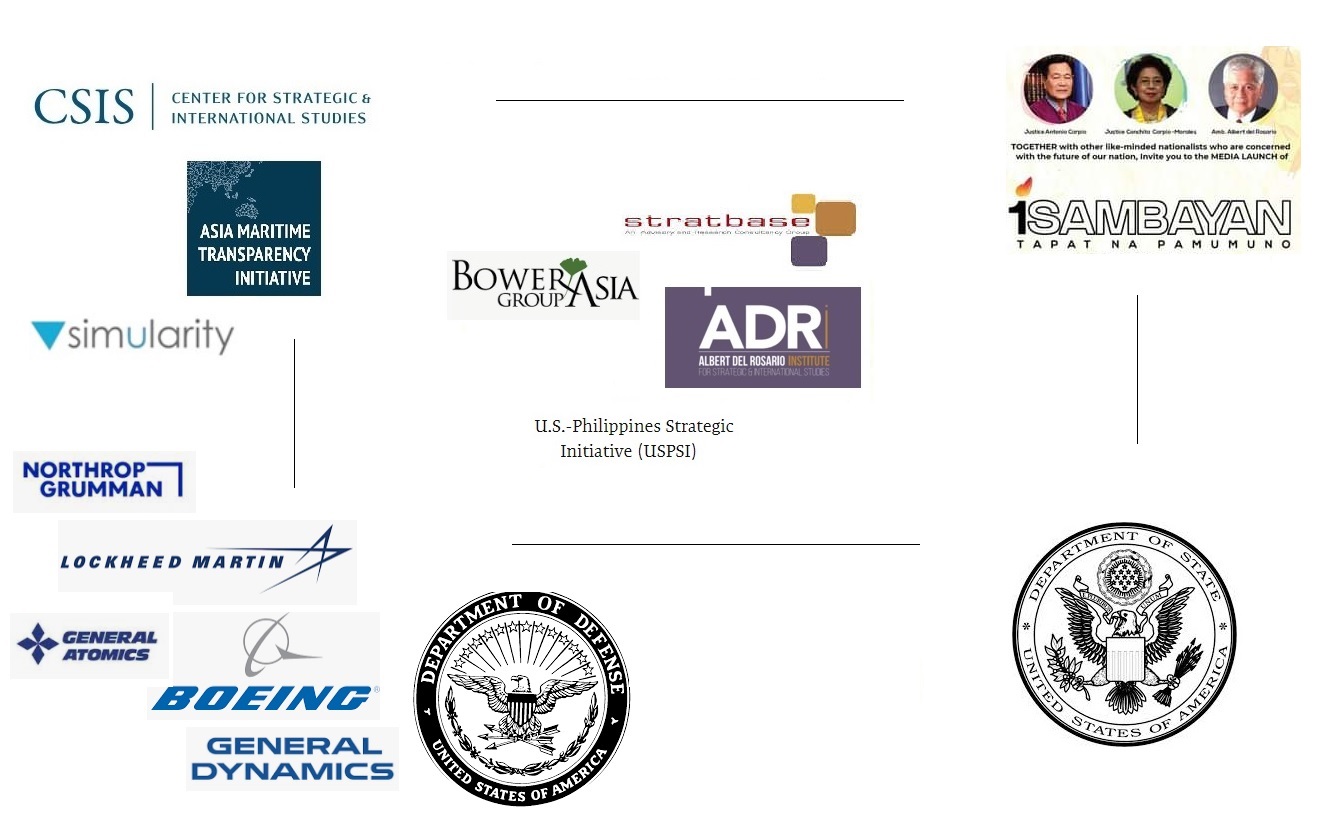
Networks of BowerGroupAsia and Stratbase/ADR
From joint patrols in 2015 to the Reef debacle – and more
It was during Rosario’s government years that Philippines filed the arbitration case against China. It was followed by the 2014 Enhanced Defense Cooperation Agreement (EDCA), which opened the country to US military, ships, and planes; for the first time since 1991.
In May 2015, the CSIS/AMTI launched a 3-year U.S.-Philippines Strategic Initiative in Washington, with keynote addresses by del Rosario, and ex-Defense Secretary William Cohen. Then, the expectation was that Senator Hillary Clinton would be the next US president. In the fall, Rosario met Antony Blinken, President Obama’s then-deputy secretary of state, in Manila.
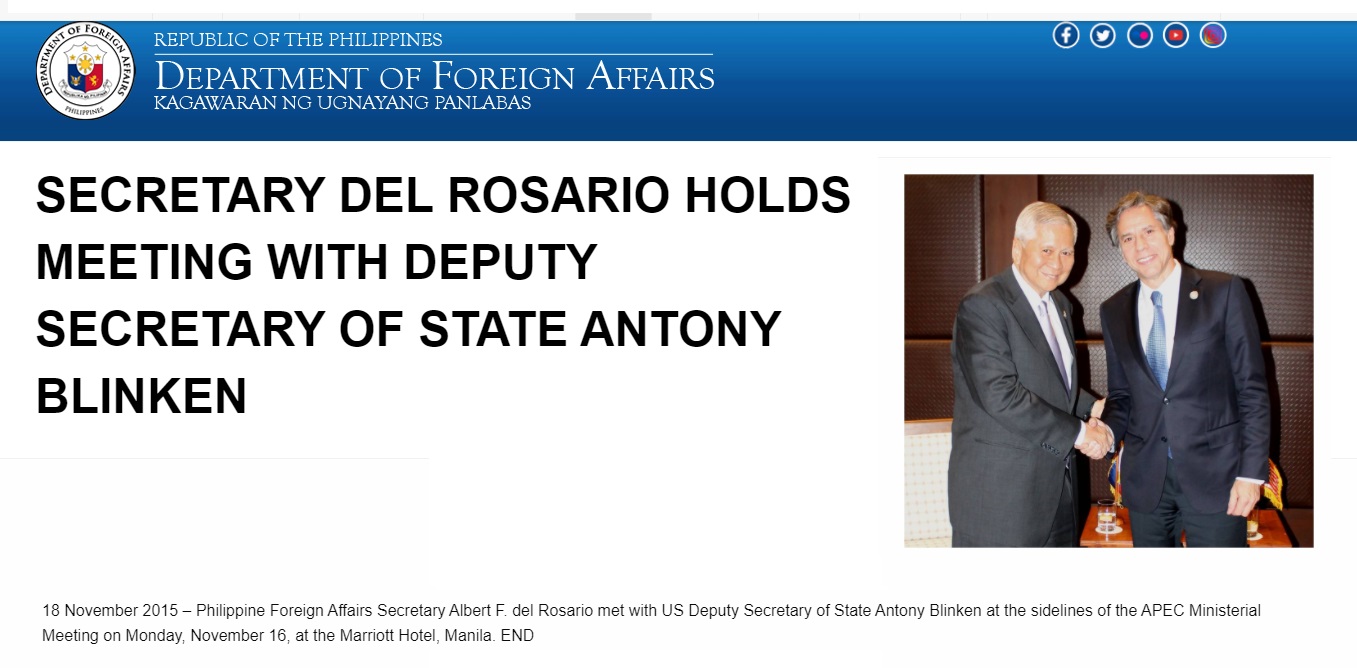
Del Rosario with State Secretary Blinken in November 2015
Source: DFA Philippines website. Retrieved on April 10, 2021
In 2016 President Duterte’s electoral triumph caused a four-year pause in these plans. Now the goal seems to be to relaunch them to preempt Duterte’s possible termination of the US-PH Visiting Forces Agreement (VFA), before it’s too late.
So, when Antony Blinken was appointed US State Secretary in January, del Rosario welcomed the appointment adding that in early 2016, "I engaged [Blinken] in DC to decide to undertake joint patrols in the West Philippine Sea.”
Recently, on April 1, del Rosario called on the Duterte administration to reconsider holding joint patrols with the US to deal with “China’s continuing unilateral aggression.”
Last Friday, in a call with Philippine Foreign Secretary Locsin, Blinken expressed concerns about “the massing of Chinese vessels at Whitsun Reef” saying that the US-Philippine mutual defense treaty applied to the South China Sea.
Concurrently, US carrier strike group, amphibious warships were massed in contested South China Sea waters, while China’s foreign ministry spokesman Zhao Lijian urged US to show restraint and cease efforts to “sow discord” in the region.
Everything old is new again.
Friction and rearmament, or peace and development
In Southeast Asia, the explicit Trump-Pompeo-Blinken objective is to rally regional countries into an anti-China front.
In the Philippines, the Duterte government has initiated a huge infrastructure investment program to achieve an upper-middle income economy. The objective of the Rosario-Carpio opposition is to play out Chinese investments and to restore the pre-2016 status quo.
Externally, Duterte has recalibrated Manila’s relations with the US and China. The goal of the opposition seems to be to sleep-walk Manila into alliance entanglements, supported by tensions in the South China Sea; to ensure continued VFA and more, even at the expense of a purposeful or accidental conflict.
Last Friday, Philippines, via Foreign Secretary Locsin, said it was “imperative” for the ASEAN to adopt a “Code of Conduct in the South China Sea whereby all parties, including China, accept restraints.”
Over time, military objectives will benefit no country in Asia, not even Washington. US goals are supported by peace and development, not by military and rearmament, as progressive Democrats and moderate Republicans know only too well. As career officer and historian Andrew Bacevich has noted, a Cold War against China is misguided and will not benefit anybody: “The immediate threats to our collective safety and well-being—perhaps even to our Republic—are here within our own continent, not on the other side of the planet. As a remedy to those threats, armed might is largely irrelevant.”
What the Philippines and Asia need, especially in the aftermath of COVID-19, is accelerated multilateral cooperation, peace and economic development – not escalated divisions, conflicts and rearmament.
A new Cold War in Asia would mean the end of the Asian Century before it has even begun.

